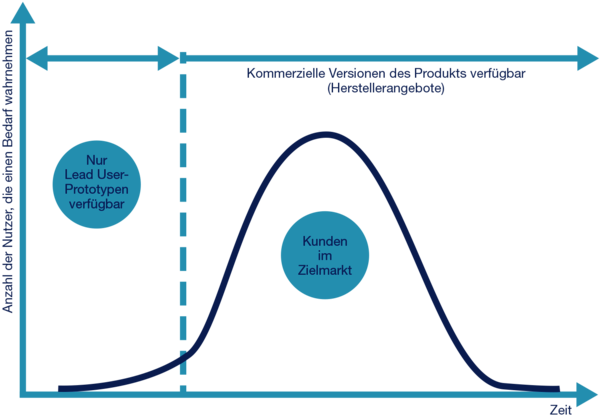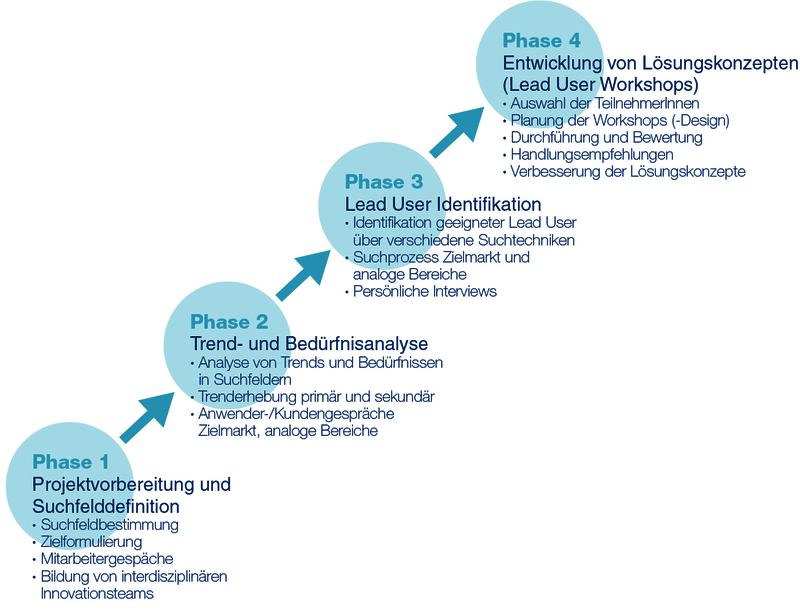Lead User - Inclusion in the earlier innovation phase
Method in brief
If the problem, for which a new solution is being sought, is not yet known, the Lead User method provides further assistance (in contrast to the innovation workshop). When it comes to identifying new customer requirements, if core customers and interested parties are systematically involved in the development of new product functions or designs, you can develop innovations more quickly and ensure they are better orientated to the market. In terms of method, you can make use of the Lead User workshops and/or particular Lead User kits.
Systematically include adept and progressive operators
Due to the technical and competitive market conditions, which change quickly, the time-frame for the development and introduction of new products, services or even processes is visibly reduced. To be able to withstand these changing requirements, quick actions and reactions to the market and the continuous development of innovations is essential for enterprises.
The classic approach of enterprises to use their R&D departments is increasingly giving way to the more powerful inclusion of Lead Users in the innovation process. The objective is to systematically apply this as the source of valuable feedback and relevant applications experiences. In this way, enterprises are able to better understand the requirements of customers within the early phase of innovation and can begin to develop suitable strategies or innovation projects based on this.
Application and use

Following Churchill, J.; von Hippel, E. and Sonnack, M. (2009, p. 33)
The Lead User method is another form of market research tool, which can be used by enterprises to develop new products, services, processes and even business models. It was originally developed by Eric von Hippel from the Massachusetts Institute of Technology (MIT) in the 1980s.
An individual is described as the Lead User when they experience and detect a need before it is served on the market. They often intensively grapple their product in their free-time and in doing so, encounter problems that have not yet been detected. It is assumed that the needs of the Lead User present the potential needs of the remaining market and lastly, that they will of interest to many other users.
Procedure

This is how you will develop innovations user the Lead User needs!
The course of a Lead User project is categorised into four phases and the duration normally varies depending on the project definition between four and nine months. Each of the four phases is defined and supported by a series of core activities. The different phases cannot be strictly separated from one another in practice and therefore, some of the activities can also be repeated in the next phase again.
Phase 1: Project preparation and search field definition
In the first phase, the focus and the superordinate subjects of a Lead User project are clearly defined and determined by the management of an enterprise. The first planning task is to define the new product or service areas and the overall objectives, which should be driven by the Lead User project. The following key questions that are to be answered are essential:
- What are the initial interests (project focus and objectives)?
- Which market types and which types of new products or services are of most interest to this project?
- What is the desired degree of innovation? (“Ground-breaking” innovations or the development of existing product or service provisions?)
- Who is the target group of end-users?
- What are the most important enterprise/business objectives and restrictions?
As soon as the focus and objectives are determined, management selects the core team to implement the Lead User study. This should be a multi-functional project team of three to four individuals with different experiences, abilities and perspectives.
Phase 2: Identification of trends and important customer requirements
Churchill, von Hippel and Sonnack (2009, p. 34) recommend the second phase to begin with a four-day team workshop. Within these four days the team should execute a detailed investigation of trends and requirements, and as a result of this they will obtain a deep understanding of the most important trends and their probable effects on the market requirements and general market information.
During the first two days, the team will begin to gain a comprehensive overview of the current and relevant literature (e.g. trade journals, market research studies). Group discussions and informal meetings are held every two to three hours led by interesting ideas and important aspects are summarised. A big challenge for the team stands alone in the assessment of which trends are particularly significant. Questions that should be asked during the trend investigation are:
- What events and conditions does the trend drive?
- Who is affected?
- What is the evidence is there to show that the trend will have a significant influence on future product and service requirements?
In this early phase of information acquisition, the team must also ask the following questions:
- What requirements and problems are there from the view of the user in practice?
- What are the views of experts on new customer requirements in the target markets?
After this, on the third and fourth days, there is an identification of experts, who deal with the so-called mega-trends or even technical trends (forecasts). Scanning literature aids in the creation of a first list of potential professionals (e.g. The authors of or named experts in articles, editors of trade journals).
If the team is confident that all the required trend and market information has been collected and the questioning has been successful, the so-called “framing” of requirements in which the customer requirements are formulated and this forms the conclusion of the second phase. It essentially contains the identification and selection of areas of needs, other data and information collection, as well as the subsequent search and definition of specific customer requirements that take centre-stage in the concept generation for a new product or service and not potential solutions for these requirements. Where possible, framing should be executed promptly after the interviews on two half-days. Provide details on the framing-process (see Churchill, von Hippel and Sonnack 2009, p. 86 et seqq.)
The result should provide a clearly formulated description on the following areas, which provide a good starting point for the identification of a suitable Lead User in the next phase.
- Customer target groups: Define the primary groups of people who will benefit from the new product to be developed or the new service, and who will be served by it.
- Basic need: Include the essential aspects of needs.
- Key attributes of the identified requirement: Naming specific features, which will optimally address the new product (or new service) on the basis of the data collected to date.
As soon as the team has a clear statement for the customer requirements, the further data collection can be performed in a far more targeted and systematic manner (Churchill, von Hippel and Sonnack, 2009, p. 85).
Phase 3: Identification of the Lead User
In this third phase the core task lies in the team attaining a more detailed understanding of the functions, features and benefits that a new product or service should provide. Solution ideas, as well as other required information, are gathered for this using the interviews with the Lead Users and experts.
The search for Lead Users normally begin with the identification of individual products users or application companies, who form
- the majority of the market in relation to your new product or service requirements, and
- are able to gain a significant advantage from the search for solutions for your requirements.
Conventional media, above all forums, blogs and diverse social media channels, as well as idea competitions can identify possible Lead Users. Through their practice experiences, they have an insight into the product or service with which most others within the target markets are not confronted.
Churchill, von Hippel and Sonnack (2009, p. 9) highlight that there are three different categories of Lead Users, who should contact the team members time and time again to obtain the best-possible information for your project. The three types of Lead Users are:
- Lead users in the target application and target market;
- Lead users of similar applications in advanced, “analogous” markets, and
- Lead users who are confronted with problems due to their practical experiences and requirements.
During this phase, provisional, alternative concepts are also developed to fulfil the customer requirements formulated in the second phase. The following questions support this:
- Which specific product/service features would a new product or service ideally provide?
- What benefits and value should this product or service provide the target customer?
- What are our expectations for the shapes that this product or service could take (e.g. important design features)?
Phase 4: Development and solution concepts with Lead Users and professionals
The main activity of this fourth phase is the execution of the Lead User workshop in which the preliminary concepts are further developed, improved or new concepts are even developed. The aim is to completely exploit as many customer-oriented solution options as possible. The Lead User workshop is a two-to-three day event at which a group of Lead Users (max. 15-18 people) and experts intensely work with the project team and other company employees on the design.
Lead Users and experts normally identify good workshop candidates from the interviews of the second and third phases. If this is not the case, then the project team must renew their search for individuals who have the corresponding expertise. More details on the procedure of a Lead User workshop are provided by Churchill, von Hippel and Sonnack (2009, p. 133 et seqq.).
Tips for Fairness
- Clear agreements on the Lead User participation conditions in activities (use or remuneration of ideas)
- Valuable communication in the Lead User workshops
Reading tips and sources
Progress report

Some universities in German-speaking countries have already been intensively engaged with the Lead User method in recent years.
Excellent descriptions, such as how companies have acted and how they have benefited from this method, can be found in the scientific-based Lead User projects in the portal for the Institute for Entrepreneurship & Innovation at the Vienna University of Economics and Business.
The portal includes a detailed description of the various topics, project processes and workshop settings.
Lead User examples from various project ventures of medium-sized enterprises include the following:
MAM Babyartikel GesmbH - Lead User project to reduce uncertainty surrounding the birth of a baby

